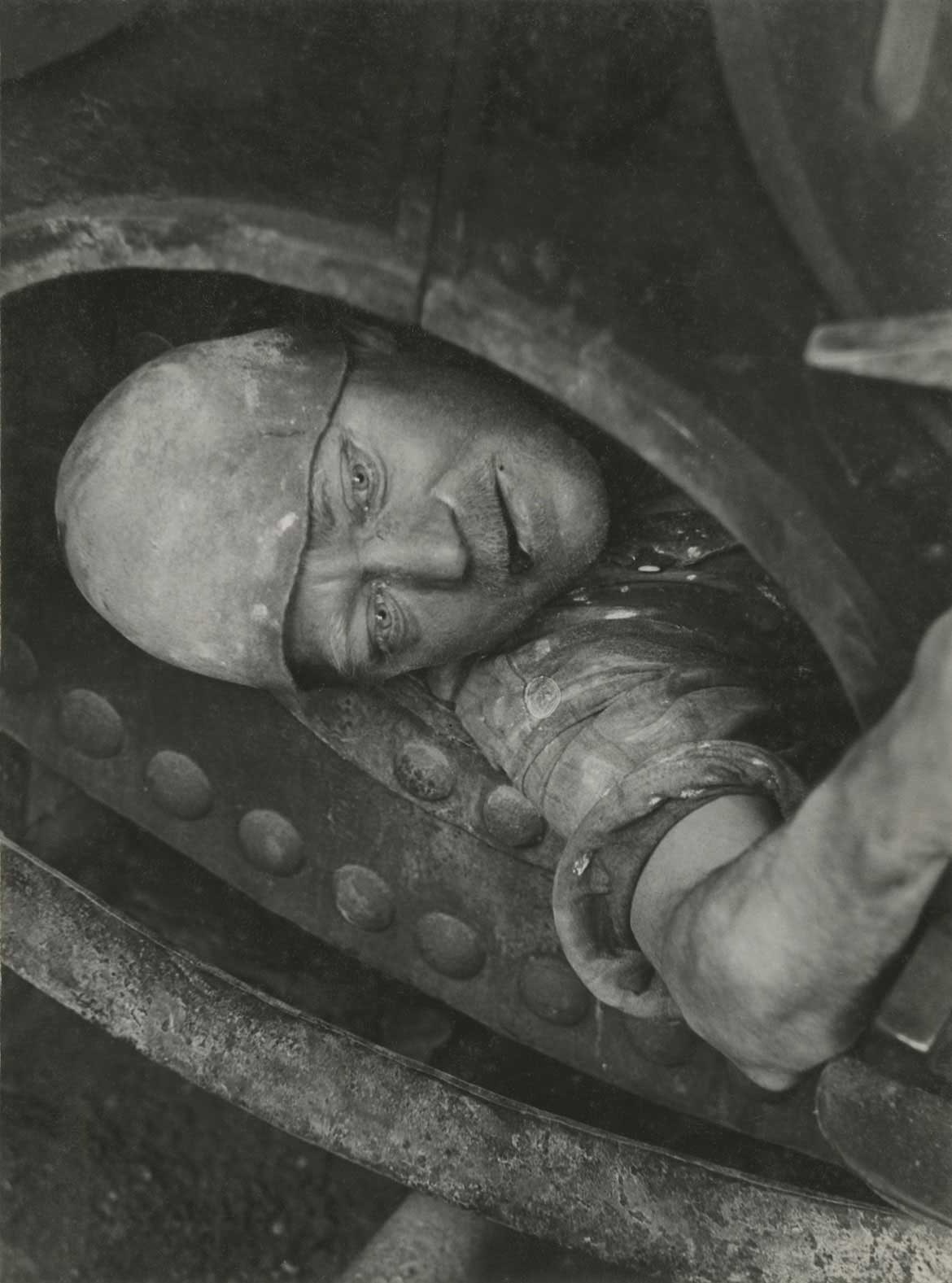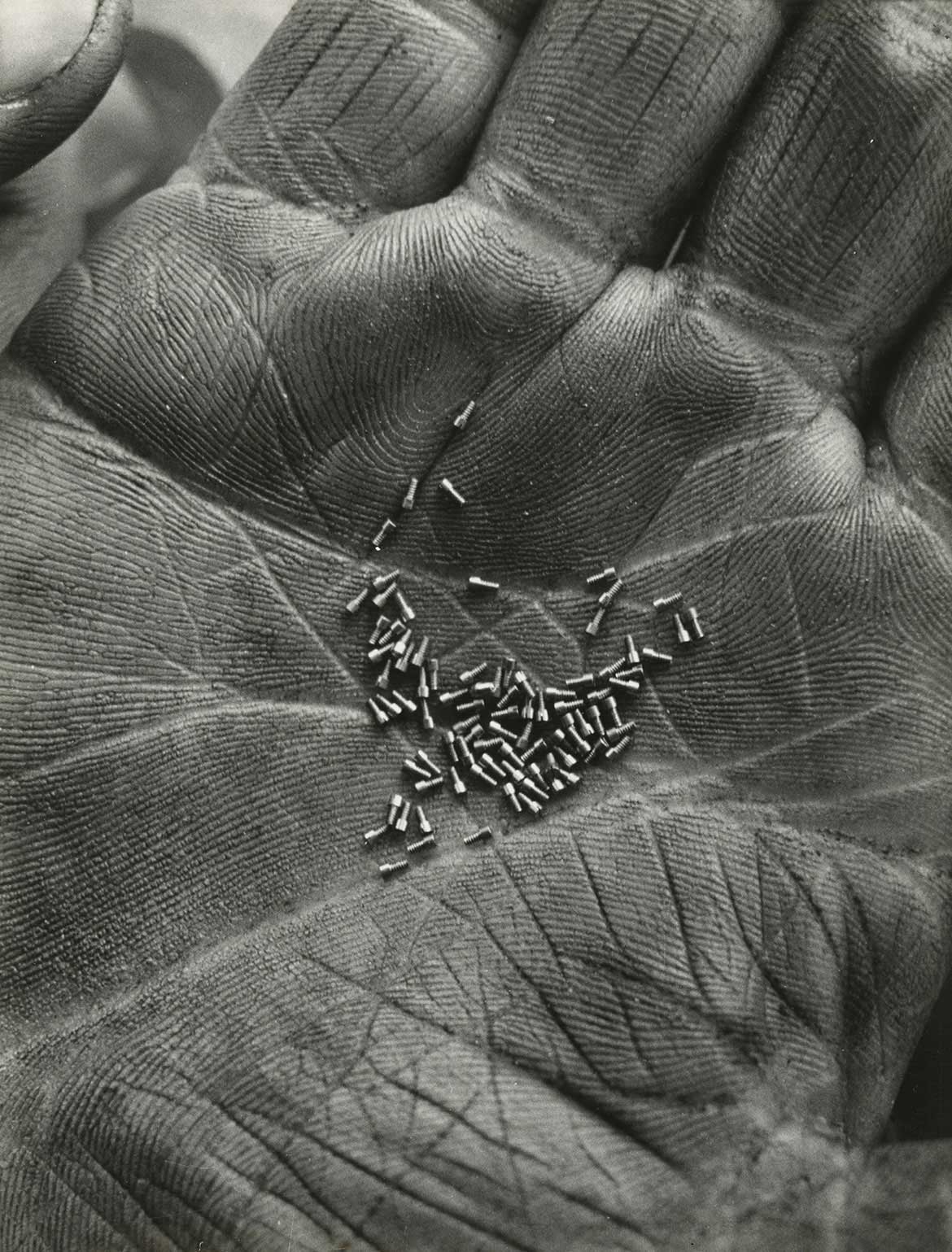Jakob Tuggener (1904-1988) is one of the exceptional figures in Swiss photography. His personal and highly expressive photographs of boisterous parties given by the upper social classes are legendary.
His book Fabrik published in 1943 is regarded as a mile- stone in the history of the photobook. The exhibition “Machine Age” focuses mainly on his photographs and films of the world of labour and industry.
These reflect not only the swift technical development from the textile industry in the Zurich highlands, or Oberland, up to and including the construction of power stations in the Alps. They also bear witness to Tuggener’s life-long fascination with all kinds of machines: from weaving looms to furnaces and turbines to locomotives, steamships and racing cars. He loved their noise, their dynamic movements and their bondless power, which he captured in images that oscillate between silent poetry and great expressiveness. At the same time he observed the men and women whose labours kept the engine of progress running – while also hinting that one day machines could dominate man.
The Machine Age
Jakob Tuggener was more familiar with the world of factories than scarcely any other photo- grapher in his day. He had completed training in mechanical drawing at Maag Zahnräder, a gearwheel company in Zurich, and worked there afterwards in their construction department. The company’s photographer Gustav Maag introduced him to the technique of photography. Due to the economic crisis in the late 1920s, Tuggener lost his job, whereupon he then fulfilled a dream he had harboured since childhood of becoming an artist, by studying at the Reimann School in Berlin. For about one year he engaged intensively with poster design, typography and film and, through the eye of his camera, became enthralled by the dynamism of the big city.
On his return to Switzerland in 1932 he began to work as a free-lancer for the Oerlikon Machine Factory (MFO), mainly for their in-house newspaper tellingly entitled Der Gleichrichter (The Rectifier). Although the company already employed its own staff photographer, Tuggener was entrusted with the task of developing a kind of photographic inside view of the enterprise, one of the aims being to bridge the gap between workers and office employees on the one hand, and management on the other. The result was several multi-part reportages, published up to the late 1930s, about the production halls and portrait series of “members of the MFO family”, as well as one-page, album–like picture series of otherwise unheeded scenes of everyday life in the factory. As of 1937, Tuggener also made a series of 16mm short films – always in black-and-white, silent and hovering between fiction and documentation. These included, for example, a surrealistic-style drama about death and transience (Die Seemühle, 1944), which Tuggener made with lay actors in an empty factory on the upper banks of Lake Walensee, or his cinematic engagement with the theme of man and machine (Die Maschinen- zeit, 1938-1970). The latter linked in with the earlier book maquette of the same name, transforming it into a moving, directly perceptible but also fleeting vision of the machine age as seen by Tuggener.

In 1943, in the middle of World War II, Tuggener published the book Fabrik (Factory). At first glance, that series of 72 photographs without texts seems like a kind of history of industrialisa- tion – from the rural textile industry to machine engineering and high tension electro- technology to the modern power plant in the mountains. On closer inspection, however, one realises that through the filmic-associative sequencing of the photographs Tuggener is also pointing to the destructive potential of unchecked technical progress. He regarded the world war raging at the time as the result of that progress. The Swiss arms industry was producing weapons for that war unchallenged. With this book, conceived in keeping with the rules of the silent film, Tuggener was well ahead of his time. Yet neither his uncompromisingly subjective photographs nor his critical approach were appropriate to the threatening situation in Switzerland, where a call was being made for unity and strength under the heading “Geistige Landesverteidigung” (Intellectual National Defence).
Although Fabrik was not a commercial success, Tuggener considered the book a great artistic success, and pursued his engagement with the themes of labour and industry. He produced two more book maquettes: Schwarzes Eisen (Black Iron, 1950) and Die Maschinenzeit (The Machine Age, 1952), which can be seen as a kind of continuation of the published book. The journalist Arnold Burgauer described that latter as a “brilliant and sparkling factual report on the world of the machine, its development, its potential and its limits”. The classical “machine age” came to an end for Tuggener in the mid-1950s, on the threshold to the computer age. Not only did the mechanical processes which had so fascinated him became increasingly invisible, he also could not and did not want to accept the idea that someday even a human heart could be replaced by a machine.
Depicter of Opposites
In Berlin in 1930 Tuggener had already begun to take photographs at the then famous balls held by the Reimann School. The thrillingly erotic atmosphere on those occasions fascinated him and he found taking photographs in dimly lit rooms a great challenge. Back in Zurich, he sought out the local night life so as to give himself up fully to the splendour and luxury of masked, artists’ and New Year’s Eve balls. He allowed himself to be lured by elegant ladies with their silk dresses, low necklines, bare backs or shoulders into a glittering fairy-tale world whose mysterious facets he attempted to explore with his Leica. Although Tuggener’s photographs of these balls were for a long time only taken note of by a small insider-group, many saw him as a “skilful depicter of our world of major opposites”, a world between brightly lit ballrooms and dismal factory halls. Tuggener too positioned himself between these two extremes by saying, “silk and machines, that’s Tuggener.” For he loved both, lavish luxury and dirty work, the bejewelled ladies and the sweating men. He regarded them as equivalent and refused to be categorised as a social critic.
Whichever world Tuggener visited, he did so with the elegance of a grand seigneur. He was a visual person with a casual but affectionate eye for the insignificant, the apparently incidental. He was not just a sensitive image-poet, but the “Number One photographic poet”, as he liked to confidently designate himself. The critic Max Eichenberger wrote of his factory photographs: “Tuggener is capable of taking photographs that not only reveal a painter but also a poet, indeed a rare magician and strange alchemist who, albeit in modest quantities, turns lead into gold.”

The exhibition
The exhibition “Jakob Tuggener – Machine Age” includes vintage and later prints from the early 1930s to the late 1950s, most of which are from the photographer’s estate. Also on show are various publications (including the portraits taken for different industrial companies such as Oerlikon Machine Factory or Rieter AG in Winterthur) and a large number of documents which shed light on the context of Tuggener’s activities in industry and his personal mode of working. In an adjoining room, a selection of his 16mm short films will be shown. These date from 1937 to 1970 and revolve to varying degrees around the theme of Man and Machine. The films have been specially digitized for the exhibition (in collaboration with Lichtspiel/Kinemathek Bern).
On the occasion of the exhibition, Steidl Verlag, Göttingen, is publishing for the first time
12 book maquettes as facsimile editions, as well as 14 short films on DVD, in a box together with an accompanying book containing essays by Martin Gasser and Severin Rüegg and an afterword by Maria E. Tuggener.
This accompanying volume and the maquettes entitled Maschinenzeit (1952) and Uf em Land (1953) are available during the exhibition as individual publications.
In collaboration with the Jakob Tuggener Foundation, Uster.With the support of Bundesamt für Kultur, Bern; Dr. Werner Greminger-Stiftung, Winterthur; Schindler Familienstiftung, Zürich; International Music and Art Foundation, Vaduz; Stanley Thomas Johnson Stiftung, Bern; Sandoz Familienstiftung, Vevey. [Curator: Martin Gasser.]
Fotostiftung Schweiz
21 October 2017 to 28 January 2018
Grüzenstr. 45
8400 Winterthur






